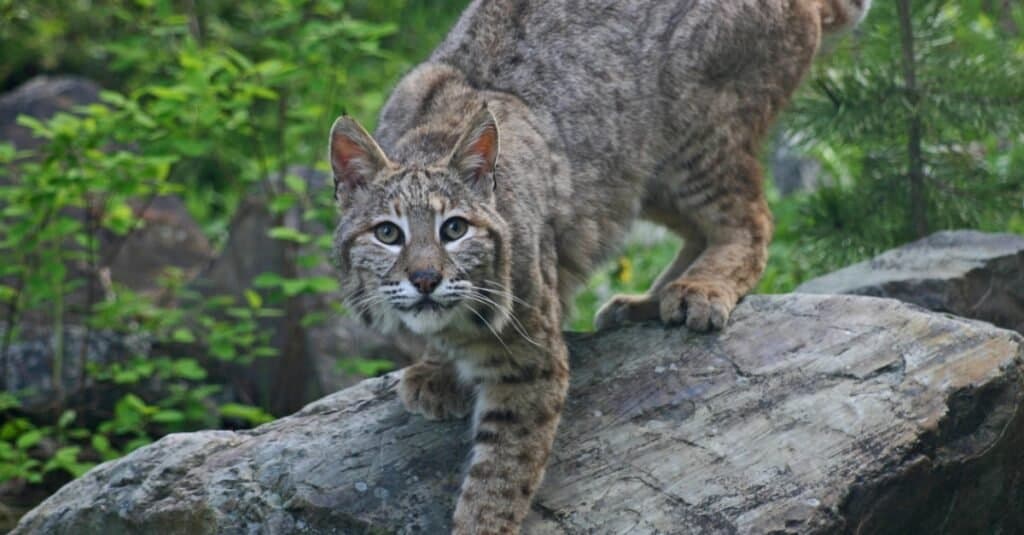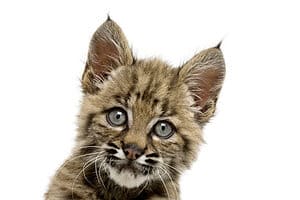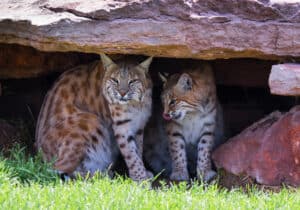Bobcats, a wild cat family member, can be found all over Northern America. Of all the wild cat species that exist in the United States, these cats have the biggest number. Even though the population of bobcats decreased in the early 20th century due to hunting for their soft spotted fur, there are still around 2 to 3 million bobcats living in the United States today.
They are very adaptive, which may cause their vast population. They may also survive in various settings, including woods, marshes, mountains, and deserts. Below, find everything you need to know about bobcats in Michigan, where to find them, and what to do when you encounter one.
What Do Bobcats Look Like?

The bobcat has big paws, sharp, black ear tips, and long legs.
©iStock.com/Anita Elder Design
Bobcats can be identified by their spots or stripes and fur hues that range from brownish-red to buff. They also feature big paws, sharp, black ear tips, and long legs. Although they share a family with the lynx and look similar, the bobcat and lynx are completely different species. Compared to the Canada lynx, the bobcat is shorter, has smaller feet and ear tufts, and frequently has a darker fur coat.
The bobcat has a white bottom, making its darker patches stand out more. Its short, black tail, which only gets as long as 6 inches, also has a white tip. The bobcat, like the lynx, has ear tufts that are believed to improve their hearing.
Bobcats in Michigan

Bobcat sightings have been confirmed in every county in Michigan.
©Victor Arita/Shutterstock.com
The entire United States is home to bobcats. While the majority of sightings have occurred in Michigan’s northern regions, sightings are also on the rise in the Lower Peninsula’s southern half. In the state, their numbers are steady enough to permit hunting and trapping in some places. In Michigan, bobcat sightings have been confirmed in every single county.
The three wild cat species that reside in the state region are bobcats, lynx, and cougars. Natural resources experts claimed that bobcats are the most common of these wild cats in Michigan. However, although bobcats are relatively common in Michigan, they are more common in the state’s northern regions and are quite hard to spot because they are most active at night.
Despite being quite widespread, particularly in Northern Michigan, bobcats are elusive wild cats. Because they are mostly nocturnal, even outdoor enthusiasts rarely spot bobcats. They have been captured on camera thanks to the advent of game cameras, though not as frequently as other Northwoods wildlife.
“Michigan Department of Natural Resource Wildlife Division surveys reveal bobcats are present throughout Michigan,” Michigan DNR Furbearer Specialist Adam Bump stated. Bump also said they had seen an increase in sighting reports of bobcats in the Lower Peninsula, indicating a “healthy, resilient population.”
How Common Are Bobcats in Michigan?
While bobcats are relatively abundant in Michigan, they are more prevalent in the northern parts of the state and are challenging. Despite their widespread presence, especially in Northern Michigan, bobcats remain elusive wild felines.
Encountering a bobcat in the wild is highly improbable due to their elusive nature.
These cats are primarily active during the twilight hours of dusk and dawn, making these periods the best times to attempt spotting one.
Where Do Bobcats Live in Michigan?

Bobcats frequently make their homes in dense vegetation, hollow trees, or rock crevices.
©Laurie E Wilson/Shutterstock.com
The majority of the state’s younger successional forest, brushy areas, and borders with a mixture of thick cover swamp environment are the habitat types that bobcats typically favor. Scientists hypothesize that the state’s Upper Peninsula has a bigger population of bobcats because there are more ups and downs in the availability of primary prey like the snowshoe hare, ground birds, rodents, and fawns.
They are extraordinarily adaptable creatures that can live in a wide range of habitats across the three nations of Canada, Mexico, and the US. While bobcats are documented to favor rocky, heavily vegetated slopes, they can also be found in a wide variety of environments throughout their natural range, including mountain woodlands, deserts, coniferous forests, swamps, and occasionally even suburban areas. Because the different coat colors enable the animal to remain as hidden in its environment as possible, the exact look of the bobcat depends on what habitat it is found in.
The bobcat’s highly developed senses and secretive temperament keep it always on the lookout for surrounding predators, particularly humans. They frequently make their homes in dense vegetation, hollow trees, or rock crevices, where they rest during the day before starting to hunt at dusk. They typically hunt from highways or trails, covering a range of two to five miles from their shelter. They also do not hibernate and are active all year long.
Bobcat Hunting in Michigan
In Michigan, the Southern Lower Peninsula’s bobcat shooting season runs from January 1 to January 11. Unless otherwise stated, each hunter is only permitted to hunt one bobcat in the state’s Lower Peninsula. In the Upper Peninsula, two bobcats may be taken by hunters and trappers as long as one is captured on private land.
Despite fierce resistance from animal rights advocates, the Natural Resource Commission unanimously approved, in March 2022, the extension of the Michigan bobcat trapping season. As a result, there will be a new season in nine counties—Ionia, Montcalm, Clinton, Kent, Muskegon, Saginaw, Gratiot, Ottawa, and Shiawassee.
What to Do if You See a Bobcat in Michigan
It may be a little unusual to encounter a bobcat during the daytime, especially if you don’t go out too much or wander around their preferred habitats. However, here are some measures you can take in case you see one:
- Don’t get too close, and maintain your distance.
- Do not flee. Running can make the bobcat instinctively chase after you.
- Without turning your back on the bobcat, carefully back away.
- Produce a loud noise by shouting, bashing a stick on a tree, or using any other method.
- Spray some water on it. Bobcats detest water, just like house cats do.
Are Bobcats a Problem in Michigan?
These cats have not historically been a major problem or nuisance, but interaction is inevitable as human populations increase in bobcat habitats and their number increases throughout the state. Most of the time, bobcats are a nuisance in rural farming communities with huge cattle concentrations, making for easy prey for these medium-sized cats.
The photo featured at the top of this post is © Jack Bell Photography/Shutterstock.com
Sources
- Bridge Michigan, Available here: https://www.bridgemi.com/michigan-environment-watch/michigan-moves-expand-bobcat-hunting-other-states-eye-restrictions#:~:text=%E2%80%9CWe've%20documented%20bobcats%20in,bobcats%20in%20the%20Lower%20Peninsula
- Hepper blog, Available here: https://www.hepper.com/wild-cats-in-michigan/
Thank you for reading! Have some feedback for us? Contact the AZ Animals editorial team.






